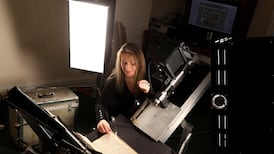A new, Irish-language brochure about European Space Agency (Gníomhaireacht Spáis na hEorpa) activities is helping to make Ireland's involvement with space more visible.
Is Muidne ESA (We Are ESA), is a translation of the colourful guide This Is ESA, and it covers ESA’s activities in space research, technology and exploration.
When the original This Is ESA guide came out in multiple languages last year, Dr Bryan Rodgers from Enterprise Ireland noticed Irish was not among them. "I thought this omission needed to be addressed, because Ireland is a founding member of the European Space Agency, and Irish is part of our culture," says Rodgers, who helps Irish companies engage in space technology developments with ESA.
0 of 3
He encouraged ESA to translate the guide into Irish and make it freely available alongside other European-language versions. The agency developed the guide as Gaeilge and published it to coincide with this year’s St Patrick’s Day.
"This is ESA reflects ESA as it is: co-operation with all of our member states is in our DNA," says Philippe Willekens, head of ESA's communications department. "We already had translations in 17 languages when the chance came to involve an Irish speaker from the ESA communication team, Ruth McAvinia, who did a great job with this version."
Replete with words such as satailít (satellite), carr Mhars (Mars rover), cóiméad (comet) and spásfort (space port), the resulting document has had a good reception on social media – including a supportive tweet from Canadian astronaut Commander Chris Hadfield – and from educators too, as it is a resource that can help students learn through Irish, according to Rodgers.
“It also recognises the work that we do in Ireland with ESA, including high-tech work in the Gaeltacht by Irish company ÉireComposites, which recently announced a new contract to manufacture advanced components for a European satellite mission.”
From Connemara to space
Tomás Flanagan, chief executive of ÉireComposites, welcomes the new guide as a resource that Irish speakers at the Connemara-based company can use. “A lot of people working at our company speak Irish in work and at home, and this guide can help them explain to their kids and families what they do,” he says.
ÉireComposites has a long history of working with ESA, and the main focus is on making strong and light components, so they can more efficiently be launched into space, notes Flanagan.
“Much of our work with ESA has been looking at thermoplastics for space, particularly carbon-fibre materials,” he says. “Using thermoplastics you can make light and strong components quickly, and we have been doing research on using these materials for space applications such as launch vehicles and satellite parts.”
The company is now working on carbon-fibre “stray light baffles” for the ESA’s Altius satellite, which is due to launch in 2023 and will monitor ozone in Earth’s stratosphere.
The Irish-made parts will attach to the side of the satellite and help prevent stray light from reaching the optical instruments on board. “These parts need to be precisely machined, otherwise there is a risk of the images being blurred,” says Flanagan. “When I was studying engineering in college, this work for ESA is the kind of project I really wanted to be doing. It is the dream job.”













